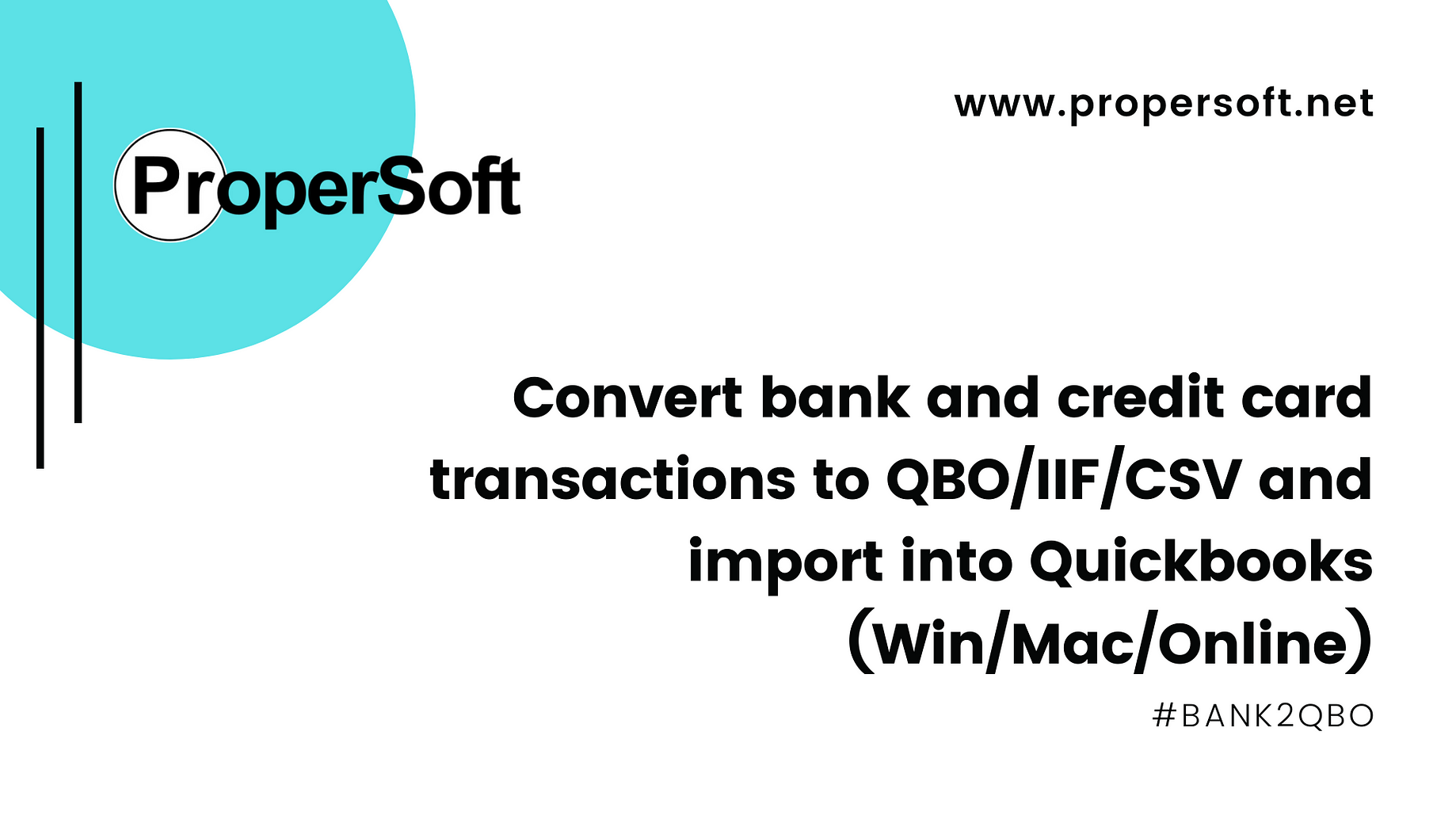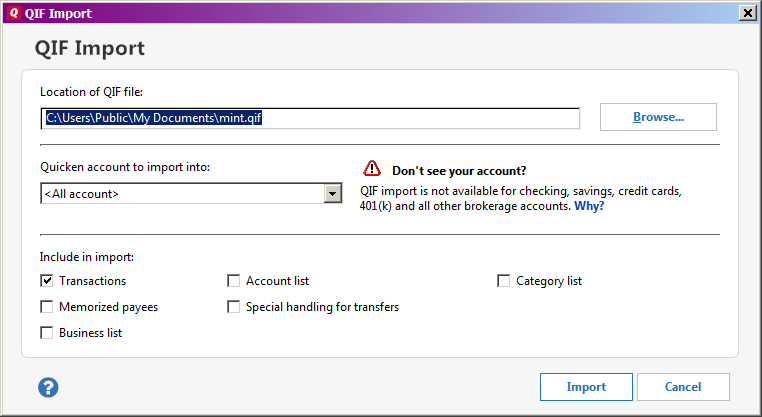Convert transaction files to the QFX format. Bank2QFX extracts transactions from CSV, XLS, XLSX, PDF, QFX, OFX, QBO, QIF, MT940, STA files. It creates QFX files ready to import into Quicken 2019-2021. No data entry: convert data you already have in bank or credit card transactions file. Windows Installer (regular download) If not yet downloaded, click on the Windows Download button above. Click 'Save' in the File Download dialog box. Choose a folder on your computer where the file will be saved and click 'Save'. Wait for the file to download and then click 'Open' button or open the folder where the file was saved and double.
Intuit is not a Mac friendly company. They make an OS X version of Quicken, but it is artificially crippled in order to try to get banks to pay them money. Intuit will only let you import files from banks that pay extra to let their customers download transactions into Quicken for Mac. The fact that you paid for Quicken and the bank paid for a Quicken server isn’t enough. They want the banks to pay another fee for their Mac users–even though there is no additional hardware or software involved. The end result is that Mac users get a product that will only work with a handful of banks. This article discusses a method to get around this limitation.
When I used a PC I was a heavy Microsoft Money user. When I switched to a Mac, I assumed that after all the good things I had heard about Quicken that I’d be better off. This did not turn out to be the case. I bought a copy of Quicken, installed it, headed over to my bank’s website and downloaded the QFX file using the WebConnect button and told Quicken to import it. I was greeted with the following error box.
Qif To Qfx Converter Free Mac
Me: Why can’t I import a QFX file into Quicken Mac.
Quicken: Because your bank doesn’t support Mac QFX files.
Me: But they are both text files based on the OFX standard.
Quicken: But banks decide which formats they want to support.
Me: Are you telling me that there is a difference between an QFX file for a Mac and one for a PC.
Quicken: Yes they are different.
Me: Why would people use OFX if it was limited to only one platform?
Quicken: I don’t know.
Me: Ok on a bank that supports the “Mac format” there is only one link to download. How can it be a different file?
Quicken: I don’t know, but banks have to support the Mac format for Mac users.
Me: I’m looking at a QFX file right now from a bank that supports Macs and one that doesn’t. The file format is identical.
Quicken: No they are different.
It was at this point that I realized I was not going to get anywhere with tech support. So I started trying to figure out what was causing the problem myself.

I don’t know what it is like to use their PC product, but from an OS X standpoint Quicken is Evil. It isn’t that their product is bad, it is that they follow absurd business practices that will make your life miserable if you are using something other than Windows. If you go to the Quicken site and look at their list of supported banks, it looks very good and reassuring. Most major banks are listed, so it should be no problem to download and import transactions. The problem is in the fine print. Very few of the banks support “Quicken for Mac”. This seems odd because the OFX, QFX and QIF file formats are completely independent of the operating system. In fact that is the whole point of OFX–to have a platform independent way of representing financial data. It should work on PalmOS, OS X, Windows, Linux, HPUX, anything.
In older versions of Quicken and other money management software, you’d simply download a .QIF file and import it. QFX can work the same way, but it contains additional information about your account and bank. Most banks have upgraded to using QFX (WebConnect) because it helps prevent repeat transactions so you don’t have to be as careful about selecting the exact dates for import.
It turns out that when you try to import a QFX file, Quicken looks at the ID of the banking institution in the file and then goes to the Intuit web site and asks if it should allow you to import the file. Intuit’s site sees that the request is coming from a Mac and then checks to see if the bank with that ID is listed as supporting the Macs. If they don’t Intuit sends back a message telling Quicken to not allow the file to be imported. Banks have to pay Intuit extra money to say that they support Mac. Since the number of Mac users is smaller than PC users, many banks don’t pay the extra fee. In my opinion this amounts to artificially crippling their product for Mac users. The files are identical for any type of computer.
There is a way around this stupid limitation. You simply tell the QFX file to use a different Bank ID number. If you choose a bank that supports “mac format”, Intuit will let you import the file.
First download the QFX (webconnect) file from your bank and then open it in a text editor. You should see a section that looks something that looks like:

INTU.BID stands for the Intuit Bank ID. and INTU.USERID is the bank’s user id. These two numbers function as the username and password to allow or disallow Mac users from importing files. Intuit allows Washington Mutual (shown above) to let their customers use Quicken on a Mac, so by replacing your INTU.BID and INTU.USERID sections with what is shown above you can import the file.
It can be a little tricky to get the file imported because you’ll need to make sure Quicken associates it with the correct account. You may need to change the name of the bank on your account before you import the file. The easiest way is to create a new account when you import the file as shown in the image. You can then go in and edit the name of the account, but you’ll need to leave the name of the bank set to Washington Mutual.
Another possible way to work around the limitation is to redirect all traffic to Intuit to your local machine and return the proper codes to authorize the transaction regardless of which bank a QFX file comes from. Ideally someone could setup their own server to act like Intuit’s server and return affirmitive responses to all requests.
Update: more information in a new article
This tutorial shows how to convert a transaction file to IIF format. We will use Bank2IIF utility. IMPORTANT: Bank2IIF is now replaced with the Transactions app, which converts from more formats and converts to more formats.
Step by step instructions for Windows
Convert Csv To Qfx
Follow the steps below for the Windows version.
Make sure you are using the latest version of Bank2IIF. Download it from the Bank2IIF download page. Start Bank2IIF and select the transaction file (it could be QBO file, OFX file, QFX file, QIF file, PDF file, MT940 file, or STA).
Review transactions before converting, check that dates are correct, have the correct year, deposits, and withdrawals are assigned correctly.
Enter the main Account Name.
To match the bank account in Quickbooks.
Map payee or payer names to Vendor or Customer names in Quickbooks. In our case, we have three expense transactions (requires Vendor to be assigned) and one income transaction (requires Customer to be assigned). Bookstore Invoice, Gas Company, Hydro, and Microsoft are Payee names.
Let's say for 'Bookstore Invoice' we have the Vendor name 'Indigo'.

Quicken Qif File Converter
Click on the 'Payee/Categories' Tab. For 'Input Payee' enter the name in the 'Output Payee' column, as you have in Quickbooks (for 'Bookstore Invoice' enter 'Indigo'). Everything else you can leave empty because the converter will not change it.
The name was changed.
Let's check the Customer's name (in our case 'Microsoft') in Quickbooks. If you don't have the same name in Quickbooks, you can add it here.
Map categories or payee names to expense account names in Quickbooks. In our case, we have four categories: Office Supplies, Utilities, Utilities, and Payroll.
Click 'Lists' - 'Chart of Accounts'.
We have 'Utilities' (Expense), which is matching.
We have 'Office Supplies' (Expense).
For the 'Payroll' - Income category. Let's say it should be 'Consulting Income'.
Click on the 'Payee/Categories' Tab. For 'Input Category' (Payroll) enter the name in the 'Output Category' column (Consulting Income).
Now we have all the things in the right order. Make sure all accounts, vendors, and customers exist in Quickbooks.
Click the 'Convert' button to create an IIF file.
Confirm the file name and location.
Qfx To Qif Money
Import created IIF file into Quickbooks
Now the IIF file is created, let's switch to Quickbooks and import created IIF file. Make sure to backup your Quickbooks data file before any IIF import. Click 'File' - 'Utilities' - 'Import' - 'IIF Files'. Locate the IIF file you've just created.
Convert Quicken Qfx To Qif
Done! Transactions are imported.
Review transactions in Quickbooks after importing. Click 'Lists' - 'Chart of Accounts' - 'Wells Fargo'.